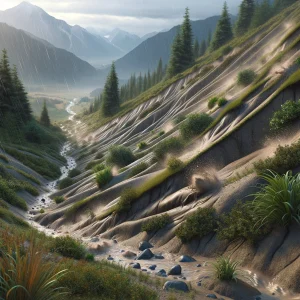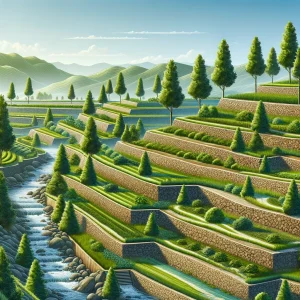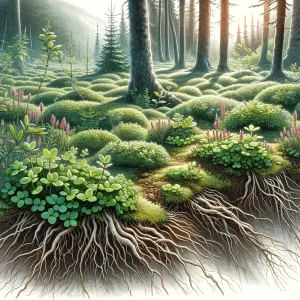Erosion is a natural process, but it can lead to significant environmental and property damage on sloped landscapes. Managing erosion effectively is crucial in British Columbia, where diverse climates and soil types dominate the terrain. This blog explores practical landscaping solutions that stabilize soil, manage water runoff, and enhance sustainability on sloped landscaping.

Understanding Erosion on Slopes
Erosion on slopes occurs when rainfall or surface runoff moves downhill, carrying soil particles. This process is accelerated by factors such as lack of vegetation, water channelling, and the physical composition of the soil. Effective erosion control methods focus on reducing water flow velocity and increasing soil stability through vegetation and structural supports.

Techniques and Materials for Erosion Control
- Terracing: Building terraces is a tried-and-true method of reducing slope length and creating flatter, more manageable areas for vegetation and water absorption. Terraces help decrease the speed of water as it moves downhill, reducing erosion potential.
- Retaining Walls: These structures support steep grades, hold soil in place, and prevent large-scale movement. Materials like stone, concrete, and timber are commonly used, each suitable for different environmental and aesthetic needs.
- Ground Cover Plants: Planting ground covers that can quickly establish a dense root system is vital for erosion control. In British Columbia, native plants such as Kinnikinnick and creeping juniper are excellent for covering ground quickly and binding soil.
- Mulching: Applying mulch provides a protective layer that absorbs water and minimizes the impact of raindrops on the soil. Organic mulches like wood chips are beneficial as they eventually decompose, adding nutrients to the soil.

Adapting to British Columbia’s Climates
The province’s range from coastal to mountainous climates means that the choice of erosion control strategy might vary. For example, in wetter coastal regions, more robust water diversion methods like French drains and extensive use of absorbent materials may be necessary to manage the larger volumes of water. Conversely, more emphasis might be placed on mulching and drought-resistant plants in dryer, interior regions to maintain soil moisture levels without excess water usage.

Case Studies: Successful Erosion Control in British Columbia
- North Shore Slopes: In this coastal region, terracing combined with native shrubs and grasses has been used to stabilize slopes. The terraces reduce runoff speed while the vegetation’s roots help bind the soil, effectively reducing erosion.
- Fraser Valley Agricultural Lands: Farmers in this area have successfully used contour plowing and cover crops to prevent soil erosion. These methods help retain water and soil nutrients, improving crop yields while protecting the soil.

Regulatory Considerations and Maintenance
Understanding local regulations is crucial for anyone planning to implement structural erosion controls. In British Columbia, particular retaining walls or significant landscape alterations may require permits or inspections to meet environmental and safety standards.
Regular maintenance of erosion control systems is also essential. This includes checking retaining walls for stability, replanting areas where ground cover has thinned, and refreshing mulch annually.
Implementing effective erosion control on sloped landscapes in British Columbia requires a thoughtful combination of techniques and materials. By understanding the specific challenges of your local environment and choosing appropriate solutions, you can significantly reduce the impact of erosion. Consulting with a local landscape professional for personalized advice and strategies is highly recommended.